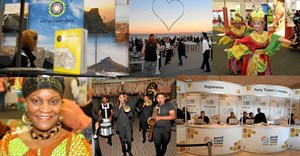Trending




 Sabre EMEA 2024 Awards: Razor PR, Retroviral top SA agenciesDanette Breitenbach
Sabre EMEA 2024 Awards: Razor PR, Retroviral top SA agenciesDanette Breitenbach
Elections 2024
Jobs
- Show Producer Johannesburg
- Fabric Weaving/Looming QC Technician Ga-Rankuwa
- Receptionist/Administrator Intern Edenvale
- Capital Equipment Sales Representative Cape Town
- Sales Consultant Bushbuckridge
- Technical Sales Representative Johannesburg
- Packaging Design Lead Cape Town
- Graphic Design Berea
- Senior Graphic/Digital Designer Cape Town
- Copywriter Cape Town
6 simple things to consider when it comes to leveraging your website

Whether you feel you’ve entered a post-website era, or you firmly believe in the value of having a home on the web, Africa Travel Week recently invited Peter Fabricius, co-founder of Springnest, to offer guidance on how those in the travel and tourism community can better leverage this platform.
Fabricius led a dedicated session as part of their Meetings & Masterclasses, a virtual series dedicated to #MakingTravelHappen again and keeping the industry connected and engaged.
As a recap of his masterclass, here are six critical factors he explored for consideration:
- Rethink your budget
Fabricius emphasises that there is no ‘magic number’ when it comes to budgeting for a website.
Ultimately, calculating a feasible budget involves looking at your business strategy, your product offering, and the return on investment that a website could potentially deliver. He also insists that a change in thinking around website budget is crucial for success.
Instead of focusing so much attention on development and design, business owners mustn’t forget about the other essential components on which success is hinged, such as content, innovation, hosting, security, and traffic.
Thinking about how to draw traffic to your website is key. After all, why build a website at all if nobody is ever going to find or interact with it?
He also acknowledges how budget is likely to be tight in current times and offers some tips for cost-cutting that doesn’t compromise quality. Many template-based website solutions look great, are readily available, and significantly reduce design and development costs.“When template-based solutions are employed, the secret is to dedicate more time and effort to differentiating your website through relatable content and branding rather than through bespoke design,” he explains.
- Security, mobile, and performance
Three aspects of a website can make or break how it is received and perceived by customers:
- Security provides both business owners and customers with peace of mind. According to Fabricius, maximising security does not have to cost a fortune. Business owners can make a huge difference to the quality of their website’s security simply by keeping their plug-ins and platforms up to date, using secure passwords and being mindful of how they share them, and obtaining an SSL certificate.
- Mobile-friendliness ensures that your website is accessible by anyone regardless of the device that they are using to browse the internet. Business owners are encouraged to conduct a mobile-friendliness test to see how their website is faring in this regard, and to figure out where adjustments and improvements can be made thereafter.
- Performance focuses on supplying the best possible user experience to further nudge customers towards conversions. Performance is measured in many ways, including by looking at loading times and navigation.
- Speak to your market segments
Travel websites are having to adapt to domestic markets during the current industry revival period, which could mean that content, visuals, and offers need to change. Speaking to the correct market segments optimises your ability to turn visitors into customers. The secret is to make your website relatable and to tap into customer emotions.
Include real people in your visuals for relatability, steer clear of generic stock photographs, focus on storytelling using emotive language, and try to view your website from your target market’s perspective. Most importantly, align your website content and value proposition with your online and traditional marketing campaigns to ensure a strong, uniform message
- Alternative communication channels
When it comes to building trust in customers, travel suppliers need to be there to answer their questions and concerns quickly and thoroughly. This is why offering access to alternative communication channels, other than phone calls and emails, can make a massive difference.
While now is a great time to invest in chatbot technology for your website, there are indeed simpler, more affordable options for those establishments that do not have the budget or tech-savviness to embrace this opportunity just yet. The key is to give customers the feeling of effortless, direct communication with your brand – and this can still be achieved through communication channels like Facebook chat and WhatsApp.
- Conversion assist
Conversion assist is all about encouraging ‘lookers’ to become ‘bookers’. It is a strategic approach to optimising conversions through the use of banners, pop-up messages, copywriting, and notification bars to generate either a sense of trust or urgency in a potential customer.
“You should never just assume that customers will find your most valuable content or special offers without any assistance. According to a survey conducted by Littledata that involved an analysis of over 400 travel sites, the average number of pages accessed per website visit was 2.6, which is extremely minimal,” says Fabricius.
“This means that your website has a very short period of time to really ‘grab’ the individual. Use the different conversion assist approaches to make sure that they see and access the features and specials that will maximise the chances of them making a conversion before the end of their session, being careful to avoid call-to-action fatigue,” he adds.
- Top-of-the-funnel SEO
SEO revolves around optimising your website for both search engines and human customers. It is all about improving the digital customer experience and supplying content that educates, inspires and/or entertains. Investigate the various stages of the funnel and create content that caters to each and every one.
For example, someone who is still researching potential holiday options might search for “best holiday destinations in South Africa”, which would also make for a great title and topic for an engaging blog post. Someone who knows that they want to head to Stellenbosch might be searching for “outdoor activities Stellenbosch”, providing Stellenbosch-based travel suppliers with the chance to draw attention to their offering.
In creating excellent content for all stages of the funnel, travel suppliers build brand awareness and relationships with potential customers, which could eventually lead to higher conversion rates.
The bottom line is that your website should cater to the needs and desires of your market segment. It should be relatable, prioritise security and performance, be easy to access across a variety of devices, make it simple for potential customers to get in touch, and constantly nudge them along the sales funnel without being too brash about it.
Most importantly, travel suppliers need to stop and look at their websites from the eyes of their customers in current times. The reality is that Covid has changed everything – and websites need to reflect this new reality.












